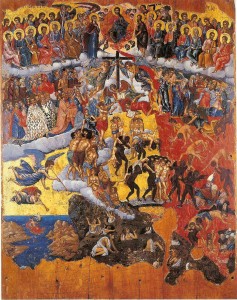 There is nothing like mulling over a concept for a few days to engender new ideas. The problem is that sometimes these new ideas conflict with previous thoughts. And this seems to be the case with my new thoughts in relation to my last post on Mark’s apocalyptic discourse, specifically his use of the “coming of the Son of Man.” In that post I argued that the phrase “coming of the Son of Man” represented Jesus’ enthronement and vindication, which portrays Jesus as the new Temple. I further argued that Mark did not anticipate, or at least did not write about, a parousia. However, upon (re)reading Thomas Kazen’s article in JSHJ entitled, The Coming of the Son of Man Revisited, I would like to propose a different (although similar in many ways) view: i.e., the Son of Man should be identified as the holy ones, or the faithful remnant.
There is nothing like mulling over a concept for a few days to engender new ideas. The problem is that sometimes these new ideas conflict with previous thoughts. And this seems to be the case with my new thoughts in relation to my last post on Mark’s apocalyptic discourse, specifically his use of the “coming of the Son of Man.” In that post I argued that the phrase “coming of the Son of Man” represented Jesus’ enthronement and vindication, which portrays Jesus as the new Temple. I further argued that Mark did not anticipate, or at least did not write about, a parousia. However, upon (re)reading Thomas Kazen’s article in JSHJ entitled, The Coming of the Son of Man Revisited, I would like to propose a different (although similar in many ways) view: i.e., the Son of Man should be identified as the holy ones, or the faithful remnant.
Much of this argument rests of the notion that the Son of Man imagery in Daniel 7 speaks of a faithful remnant. Thus, the ascension of the Son of Man is the vindication of the remnant, who receives the kingdom and dominion. This is the view that Kazen promotes in his article, to which he applies to the Gospel accounts, specifically Mark and Matthew. However, before he explicates how this view makes sense of some odd passages in Mark, he first deals with the parousia tradition in Paul. Dealing specifically with 1 Thess 4.13–18, he notes that while Jesus is directly linked to the parousia (v. 15; i.e., Jesus is expected to return), the Son of Man imagery is instead reflected upon the believers[1]. Note that v. 17 envisions the holy ones as being “caught up in the clouds” and so vindicated. Thus, while the Son of Man imagery and the parousia are linked, their only connection is that they are incorporated into the same event, not that they represent the same person! Furthermore, if this is Paul’s understanding of the Danielic “Son of Man” imagery, we are confronted with evidence that at least some Jews interpreted the imagery in a collective sense, representing kingdom restoration for the faithful remnant.
This interpretation alleviates some critical tensions with my previous view of Mark 13.24–27 (although, it may engender other tensions). One major problem was the question of where the parousia tradition began and how to account for its absence or presence in certain NT authors. If the tradition originated with Jesus, we would certainly expect Mark to pick up on it. If it did not originate with Jesus, did Paul invent the anticipation of a second coming and why? But with Kazen’s insight into Paul’s restorative anticipations, Mark’s account becomes clearer and even harmonizes with an early tradition (against my last post)[2]. Thus, what we find in Mark is the destruction of the Temple (13.24–25) followed by the Son of Man tradition (13.26), which, in this view, represents the vindication of the holy ones[3]. Verse 27 alludes to Isa 11.12 as “he” will gather the elect. If the one who sends the angels is to be identified as Jesus, we may find here an expectation of parousia. Mark’s account does not necessarily indicate a descending Jesus as much as an appearing Jesus, but nevertheless, it can easily be seen as referring to the same event. But there is a key distinction to be made, that while Mark does indicate a parousia, Jesus and the parousia are only connected with the Son of Man tradition via an event and not because the latter is personified by former. In this sense, the parousia is not directly identified with the Son of Man tradition but is rather identified with the gathering of the saints and the restoration of kingdom! Therefore, what we find in Mark 13.24–27 is the anticipated restoration of the kingdom to the remnant (Dan 7 and “Son of Man”) and the gathering of God’s people (Is 11.12)[4].
One implication of this interpretation is that Jesus is no longer being set up as the new Temple in and of himself. With the claim of destroying the Temple only to build another in three days (14.58), it is difficult to remove Jesus from the Temple imagery. But this does not mean that the holy ones cannot be assumed into the new Temple at restoration and thus become a part of its structure.
In line with the last consideration the idea of Theosis is prominent in Mark 13.24–27 and certainly applicable to this new Temple ideology. The holy ones are mentioned in a context containing theophanic imagery: “clouds” (Exod 16.9–10; 24.9–17) and “glory” (Exod 16.9–10; 24.9–17; 34.18)[5]. Furthermore, the vindication follows the distress of the “stars,” which fall from heaven, and the “powers” (angels? gods?). Notice also that the shaking “powers” are most likely those who see the holy ones coming in “power” (Mark 13.25–26), possibly emphasizing the replacement of roles and positions. In other words (if I may get back to my main point), it seems plausible that Jesus and the holy ones constitute the new Temple, as the holy ones are portrayed in theotic imagery. Thus, in the same way we see Paul anticipating a future resurrection in light of the resurrection of Jesus, Mark anticipates the believers’ constitution of the new Temple in light of Jesus’ as the already reconstructed new Temple.
Overall, with this interpretation there are many facets to be examined and many more books to be read.
[1] Coming, 159; Contra Plevnik, Paul and the Parousia, who asserts that 1 Thess 4.16–17 is unique in that it is the only passage in which believers are in the clouds. He makes this case by presuming that the Gospel accounts speak of the “Lord” coming in the clouds (60). But this interpretation reflects an a priori assumption that the Son of Man is Jesus in the Gospel accounts. Edwards Adams also recognizes that the clouds are associated with the believers but fails to make a connection between the cloud imagery of 1 Thess 4.17 and the Son of Man imagery in Daniel 7.13 (“The ‘Coming of God’ Tradition,” in Biblical Traditions and Transmissions, 14). Major commentaries follow suit in affirming Jesus as the Son of Man in the Gospels, which proves seminal for their interpretations of the cloud imagery primarily reflecting Jesus and only secondarily connect to the remnant (Fee, Thessalonians, NICNT, 180; Wanamaker, Thessalonians, NIGTC, 175; Malherbe, Thessalonians, AB, 276–77; Bruce, Thessalonians, WBC, 105).
[2] Coming, 168–69.
[3] This view, in my opinion, removes the tension of Jesus’ double vindication associated with identifying Jesus as the Son of Man, in which he is vindicated following the destruction of the Temple, and his vindication at the resurrection, when he assumes the role of the new Temple (Mark 14.58). In the present view of this post, Jesus’ vindication is at the resurrection and the vindication of the Son of Man is reserved for the holy ones.
[4] While Daniel 7 includes a judgment on the fourth kingdom, Mark does not explicitly reflect a judgment at this time. While it may be assumed, it is Matthew’s account that explicitly emphasizes judgment and identifies Jesus as judge (Kazen, Coming, 169; Sim, David C. Apocalyptic Eschatology in the Gospel of Matthew. Vol. 88 SNTSMS. Cambridge: Cambridge Press, 1996.
[5] Burnett has a good article on Paul’s realized theotic expressions in Colossians, in which he provides many Biblical and extrabiblical references for theophanic imagery involving “clouds” and “glory.” In fact, much of what David suggests is being revealed in Paul’s language could be transferred to Mark’s account.



Somebody has been reading and listening to me! Good post.
Thanks David. I certainly found your post helpful for acquiring the correct terminology. I must admit, I am a bit of a neophyte when it comes to angelmorphism, theosis, and all that jazz, but I am looking forward to reading up on it.
Well there will be more coming on my end in the future, especially in terms of the Hebrew Bible and Second Temple background to those concepts in the NT. It is precisely what I am interested in (you know this).
After reading this again Daniel, I noticed something in footnote #4. You say “While Daniel 7 includes a judgment on the fourth kingdom, Mark does not explicitly reflect a judgment at this time”; here’s what I began to think… you might be wrong here. The fact that you might be wrong though may help your interpretation along even further. I think I may do a follow up post on this!
Ha! Thanks for the ellipsis. I look forward to the revelation behind such mysteries.